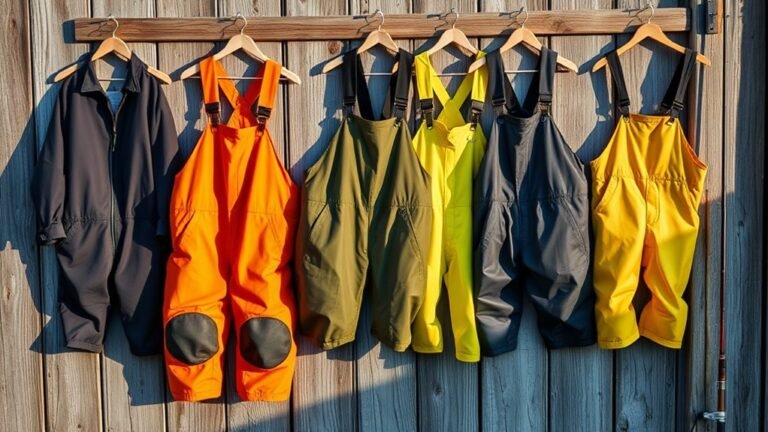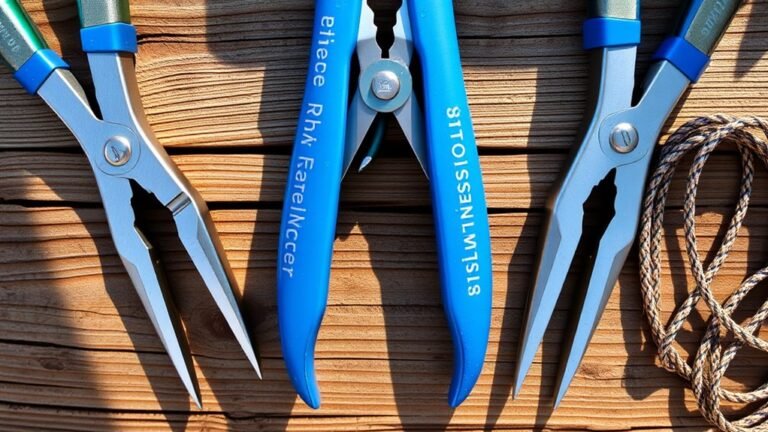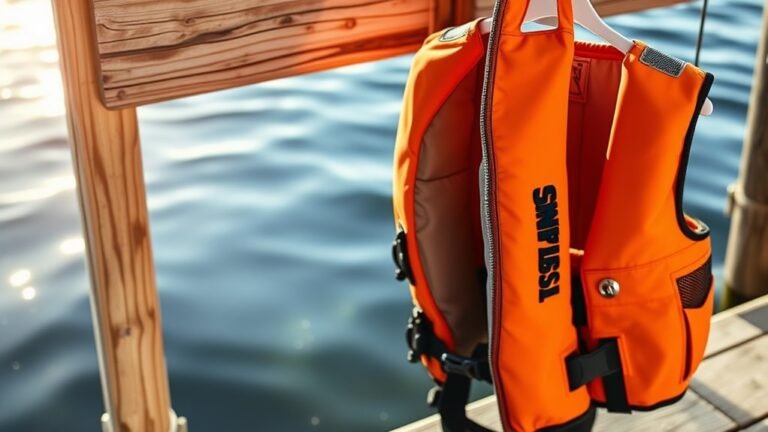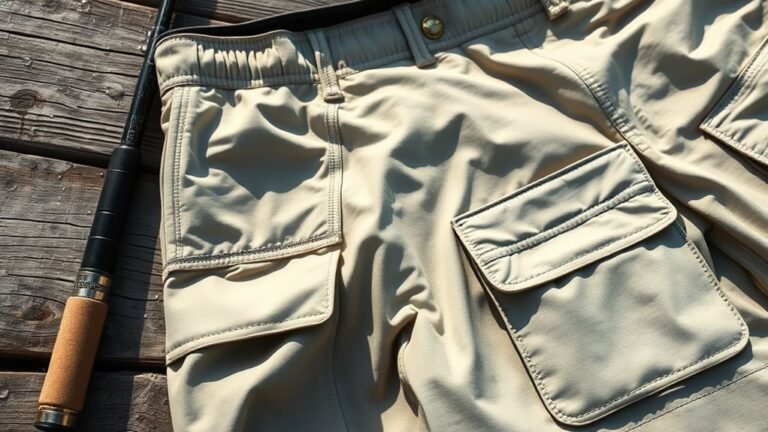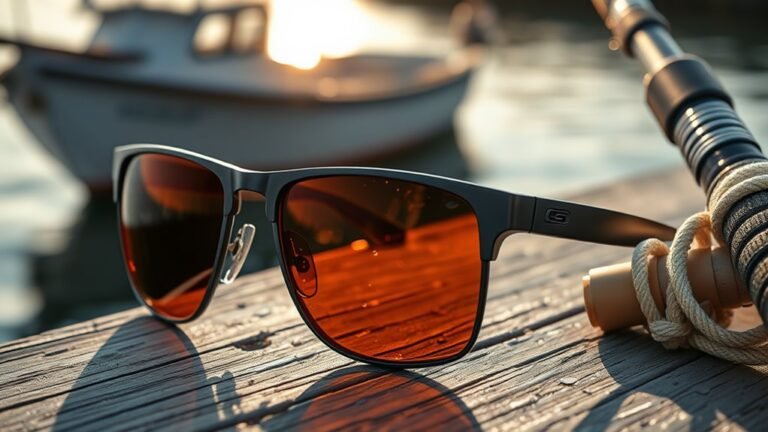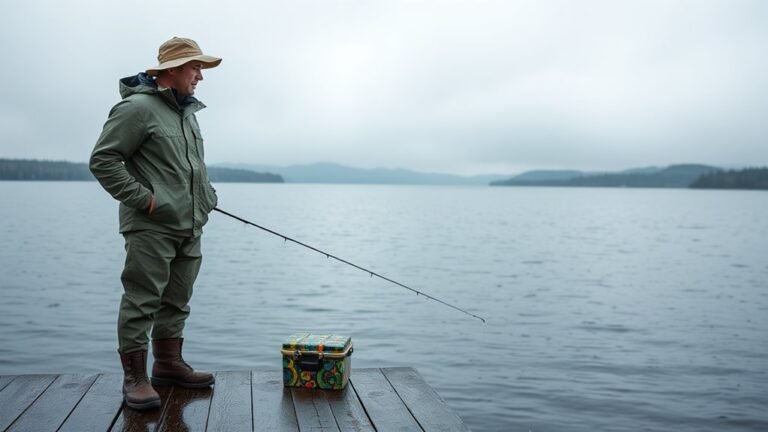3 Best Fishing Lines for Crappie
Crappie have a highly developed lateral line system and excellent eyesight, allowing them to detect fishing lines up to 50 feet away.
To avoid spooking these sensitive fish, it's crucial to select a line that offers the right balance of invisibility, strength, and handling.
With numerous fishing lines available, only a few are suitable for crappie fishing.
Let's explore three proven options that will increase your chances of success on the water by outsmarting these cautious panfish.
Key Takeaways
- KastKing TriPolymer Crappie Advanced leads with its three-layer nylon construction, superior abrasion resistance, and low visibility properties.
- Lews Mr. Crappie excels with its low memory design and versatility, offering multiple color options for different fishing conditions.
- KastKing Premium Monofilament stands out with Paralleled Roll Track technology, ensuring smooth casting and near-invisible presentation.
- Choose fishing lines between 2-6 pounds test strength for optimal crappie fishing performance and sensitivity.
- Look for lines with low stretch, high abrasion resistance, and minimal visibility to increase success rates.
KastKing TriPolymer Crappie Advanced Monofilament Fishing Line
Prices pulled from the Amazon Product Advertising API on:
Product prices and availability are accurate as of the date/time indicated and are subject to change. Any price and availability information displayed on [relevant Amazon Site(s), as applicable] at the time of purchase will apply to the purchase of this product.
The KastKing TriPolymer Crappie Advanced Monofilament stands out with its unique three-layer nylon construction, offering superior line control for crappie fishing. Its blend of Nylon 6, Nylon 6,6, and Nylon 12, processed through a specialized triple cross head extrusion, enhances casting distance and minimizes friction. This line mimics fluorocarbon's low visibility while providing 12% less stretch than traditional copolymer lines, making crappie bites easier to detect.
With superior abrasion resistance, this line outperforms standard monofilament by up to two times, reducing line failure risks during larger fish fights. Despite occasional line twists with casting rods, its strength, smoothness, and durability make it reliable for both freshwater and saltwater crappie fishing.
Best For: Crappie anglers seeking high-performance monofilament with excellent sensitivity, low visibility, and superior strength.
Pros:
- Advanced TriPolymer construction ensures exceptional strength and abrasion resistance
- Low light refraction renders the line nearly invisible underwater
- Reduced stretch (12% less than traditional lines) enhances bite detection
Cons:
- Potential line twisting with casting rods
- Higher price compared to standard monofilament lines
- Some users report inconsistent spool quality
LewsMr. Crappie
Prices pulled from the Amazon Product Advertising API on:
Product prices and availability are accurate as of the date/time indicated and are subject to change. Any price and availability information displayed on [relevant Amazon Site(s), as applicable] at the time of purchase will apply to the purchase of this product.
Crappie anglers will appreciate Lews Mr. Crappie monofilament line, highly rated by over 1,500 users. Its low memory design minimizes line twist and boosts casting distance, ideal for small reel applications. Available in hi-vis, clear, and camo, it adapts to various fishing conditions.
Crafted from nylon, the line features an abrasion-resistant formula and, despite its 6-pound rating, can handle larger fish like 10-pound northern pike. It excels in panfish and jig fishing, offering smooth casting and durability. The 3 x 3 x 3-inch spool provides ample line for multiple reels, delivering excellent value for crappie enthusiasts.
Best For: Crappie and panfish anglers needing a high-visibility monofilament line for small reels.
Pros:
- Low memory design reduces line twist and enhances casting distance
- Multiple visibility options (hi-vis, clear, camo) for varied conditions
- Durable with strong abrasion resistance, capable of landing larger fish
Cons:
- Limited to 6-pound test weight, which may not fit all scenarios
- No warranty provided
- Some may find the line diameter thick for ultralight use
KastKing Premium Monofilament Fishing Line
Prices pulled from the Amazon Product Advertising API on:
Product prices and availability are accurate as of the date/time indicated and are subject to change. Any price and availability information displayed on [relevant Amazon Site(s), as applicable] at the time of purchase will apply to the purchase of this product.
The KastKing Premium Monofilament Fishing Line offers exceptional value and performance, making it ideal for crappie fishing. Its Paralleled Roll Track technology ensures low memory, facilitating easier casting and management. The line's superior clarity helps keep it invisible to wary crappie fish.
Durability is enhanced by its abrasion resistance and low absorption, reducing line breakage at knots and enabling quicker retrieval. Available at 4 pounds and 300 yards, it suits both freshwater and saltwater fishing. Boasting a 4.5-star rating from over 9,500 users, it provides professional-grade quality at a competitive price, with smooth casting enhancing the fishing experience.
Best For: Crappie fishing enthusiasts seeking a reliable monofilament line with excellent value and performance in various water conditions.
Pros:
- Superior clarity and low visibility ideal for catching cautious fish
- Paralleled Roll Track technology ensures low memory for smoother casting
- Durable with abrasion resistance and reduced knot breakage at a good price
Cons:
- Limited to 300-yard spools, which may not meet all fishing needs
- Not suitable for specialized uses like cross-stitching due to translucency
- Some users may prefer higher pound test options for larger fish
Factors to Consider When Choosing Fishing Lines for Crappie
When selecting the perfect fishing line for crappie, you'll need to weigh several critical factors that can make or break your fishing success. You should carefully evaluate the line's strength and weight, its visibility underwater, abrasion resistance, stretch characteristics, and casting capabilities to match your specific fishing conditions and techniques. Your choice will ultimately affect everything from your ability to detect subtle bites to how well you can present your bait in different water conditions.
Line Strength and Weight
Choosing the right line strength and weight is crucial for successful crappie fishing. Opt for lighter line weights between 2 and 6 pounds to balance strength and sensitivity, essential for targeting these finesse-focused fish. Your line's strength should exceed the crappie's expected weight, but avoid going too heavy.
A lighter pound test enhances casting distance and accuracy, enabling precise lure placement where crappie are located. Lighter lines also improve sensitivity, making it easier to detect crappie's subtle bites. Pay attention to knot strength, ensuring the line maintains integrity when tied while allowing for natural bait presentation.
Ensure your line has enough strength to land fish, but avoid overly heavy lines, which can reduce effectiveness and lower bite chances.
Underwater Line Visibility
Underwater visibility is crucial for successful crappie fishing. Crappie are less likely to bite if they detect your line, so it's important to choose a line that remains as invisible as possible underwater. Opt for lines with materials like fluorocarbon or multi-layer nylon polymers that match the water's light refraction.
To improve stealth, use lines designed for low visibility, including those with camouflage coloring for clear waters. Consider environmental factors such as water clarity, fishing depth, and time of day when selecting your line. Adjusting your line's visibility features to specific conditions will significantly enhance your chances of catching crappie.
Abrasion Resistance Properties
Abrasion resistance is crucial for successful crappie fishing, protecting your line from underwater obstacles like rocks and branches. Modern fishing lines with enhanced abrasion resistance can outperform traditional monofilament lines, offering better durability and knot strength for larger crappie. Opt for lines with low memory to prevent twists and kinks, ensuring consistent performance and reducing the need for frequent line replacements.
Stretch and Sensitivity Balance
Selecting the right fishing line for crappie involves balancing stretch and sensitivity to maximize your catch rate. Low-stretch lines enhance sensitivity, allowing you to detect subtle crappie bites, while too much stretch, like in traditional copolymer lines, can obscure these delicate strikes. Monofilament lines offer a good compromise with adequate stretch and sensitivity, especially in situations where line visibility is crucial. For improved performance, consider newer proprietary line blends designed for crappie fishing, which optimize the stretch-to-sensitivity ratio and enhance energy transfer during hook sets.
Casting Distance Capabilities
When selecting a crappie fishing line, prioritize casting distance capabilities. Choose lines with low memory and smooth surfaces to reduce friction, enhancing both distance and accuracy. Opt for lighter, thinner lines to minimize air resistance, but ensure they offer good abrasion resistance for consistent performance. Additionally, select lines designed to minimize twisting, as this improves control and consistency in casting, increasing your chances of successfully targeting crappie.
Frequently Asked Questions
What Is the Best Time of Year to Fish for Crappie?
You'll find the best crappie fishing during their spring spawning season, typically from mid-March through May when water temperatures reach 56-65°F. They'll move to shallow waters near shorelines and structures to spawn. Fall offers another prime opportunity as crappie school up and feed heavily to prepare for winter. During these seasons, you'll catch them in 6-15 feet of water around submerged brush, fallen trees, and dock structures.
Should I Use Live Bait or Artificial Lures for Crappie Fishing?
Both live bait and artificial lures can be effective for crappie fishing, but your choice should depend on the conditions. Live minnows are excellent natural bait, as they're a staple in a crappie's diet. You'll also have success with artificial lures like small jigs, soft plastics, and crankbaits. If you're new to crappie fishing, start with live minnows since they're easier to use, then progress to artificial lures as you gain experience.
How Deep Do Crappie Typically Swim?
Playful and persistent crappie typically swim at varying depths throughout the year. You'll find them between 5-15 feet during spring spawning season, when they move to warmer shallow waters. In summer and winter, they'll dive deeper, often holding at 20-30 feet. During fall, you can spot them at mid-depths around 15-20 feet. Remember, they'll follow their preferred temperature range of 68-72°F regardless of season.
What Pound Test Line Is Best for Catching Trophy-Sized Crappie?
For trophy-sized crappie, you'll want to use 4-6 pound test line as your primary choice. This strength provides the perfect balance between sensitivity and durability. While you could go up to 8 pound test, it might reduce your feel for lighter bites. If you're fishing in areas with heavy cover or structure, consider using 6 pound test to give you extra confidence when pulling big crappie away from snags.
Can I Use the Same Fishing Line in Both Warm and Cold Water?
Like a reliable all-season tire, most modern fishing lines can handle both warm and cold water conditions. You'll notice that fluorocarbon and braided lines perform consistently year-round, while monofilament can become slightly stiffer in cold temperatures. If you're fishing in extreme temperature changes, you might need to adjust your line tension, as cold water can make the line less flexible. It's best to store your line at room temperature when not in use.
Conclusion
You now know how to select the ideal crappie fishing line. Whether you choose KastKing's TriPolymer, Lews Mr. Crappie, or KastKing Premium Monofilament, these lines provide the sensitivity and control you need. The fish won't care about the brand as long as they can't see it. Remember, if the big one gets away, it's the angler's story that truly matters.


